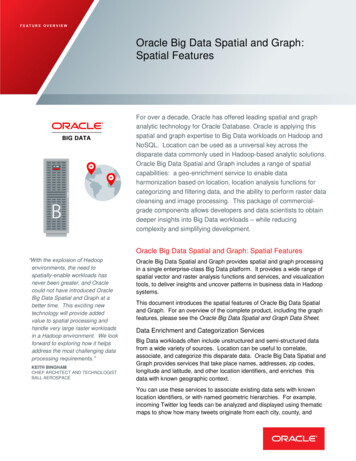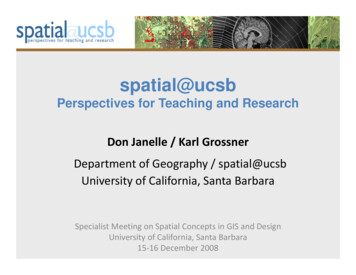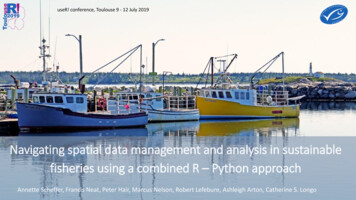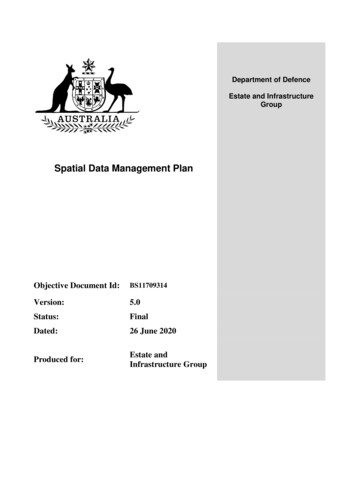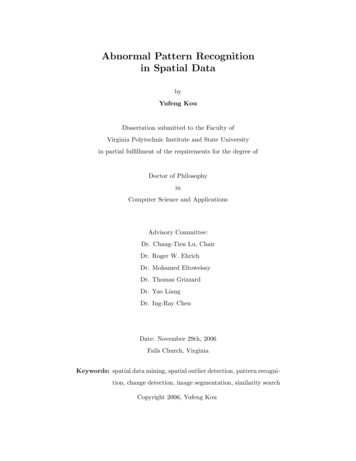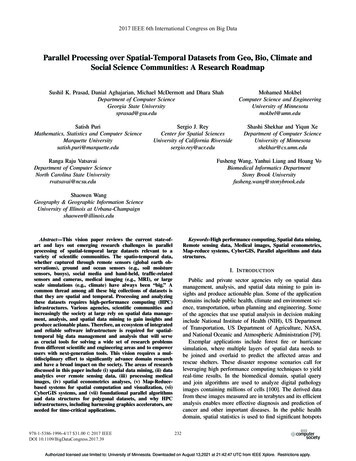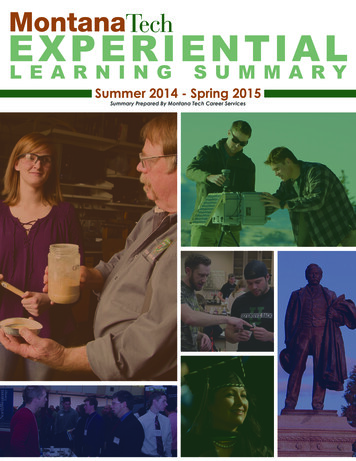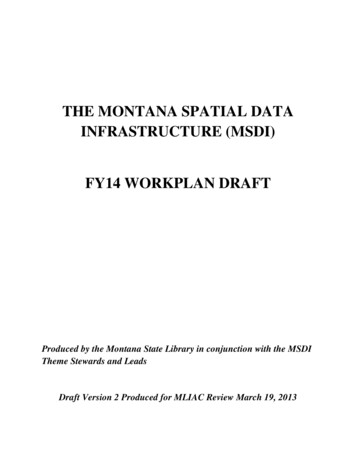
Transcription
THE MONTANA SPATIAL DATAINFRASTRUCTURE (MSDI)FY14 WORKPLAN DRAFTProduced by the Montana State Library in conjunction with the MSDITheme Stewards and LeadsDraft Version 2 Produced for MLIAC Review March 19, 2013
TABLE OF CONTENTSACRONYMS USED IN THIS DOCUMENT. 1MSDI DATA WORK PLAN . 2MSDI EDUCATION, OUTREACH AND COORDINATION . 2MSDI THEME MAINTENANCE . 3FY 2013 PROJECT PRIORITIES – ENHANCMENT, RESEARCH AND DEVELOPMENT . 4MSDI FY14 WORK PLAN – AVAILABLE RESOURCES. 6APPENDIX A – FY13 STEWARD/LEAD PROPOSED PROJECTS. 8
ACRONYMS USED IN THIS DOCUMENT1.2.3.4.5.6.7.8.9.10.11.12.13.BLM – U. S. Department of Interior’s Bureau of Land ManagementFME – Safe Software’s feature manipulation engineETL – common for enhance, translate and load data transactionsGCDB – BLM’s Geographic Coordinate Data BaseMAGIP - Montana Association of Geographic Information ProfessionalsMCPD – Multi-State Control Point DatabaseMDT – Montana Department of TransportationMBMG – Montana Bureau of Mines and GeologyMTNHP – Montana Natural Heritage ProgramMSDI – Montana Spatial Data InfrastructureMSL – Montana State LibraryNRCS – U. S. Department of Agriculture’s Natural Resource Conservation ServiceNRIS - Natural Resource Information System; part of the MSL Geographic InformationProgram14. PLSS – Public Land Survey System15. USGS – U.S. Department of Interior’s United States Geologic SurveyPage 1 of 8
MSDI DATA WORK PLANThe Montana State Library (MSL), working with Montana Spatial Data Infrastructure (MSDI) themestewards and theme leads, has compiled maintenance plans and enhancement priorities for each MSDItheme. It is based on the same template as the FY13 work plan and focuses on the three types of tasksthat comprise MSDI stewardship:1. MSDI education, outreach and coordination2. MSDI maintenance3. MSDI enhancement, research and developmentWhile there are differences in the nature of data content associated with each theme, there also aremany similarities. For each theme an Excel worksheet captured the tasks and estimated hours toaccomplish a base work level for categories one and two that would keep each theme at today’s levelsin terms of content and access. We also estimated hours to complete projects to improve content andaccess. Each theme worksheet was aggregated into a master worksheet to estimate the total MSDIworkload for FY13. Each individual theme’s worksheet is not included in this plan however examples areused. This year’s MSDI plan focuses more on the projects and vision for each theme rather than theprocess since the MLIAC reviewed and accepted the process for the FY13 plan. Theme stewards andleads have again provided their best estimates of the level of effort required to provide outstandingtheme stewardship.MSDI EDUCATION, OUTREACH AND COORDINATIONMSDI education, outreach and coordination are required for each and every theme and go far beyondwhat a state GIS coordinator can accomplish. Each theme steward/lead must conduct some basiccoordination and outreach tasks to meet user needs. Those basic functions or common outreachinclude things like work plan development, user outreach, technical support to users, and updating atheme’s web presence. A theme might have some specific outreach identified. For example theStructures and Addressing coordinator has identified a need for organizing a Montana AddressingSummit in FY14, bringing together major 911 vendors, local addressing coordinators, the U.S. CensusBureau, the State SITSD Public Safety Services Bureau and other stakeholders to discuss addressingmethodology and common interests. Finally, there is cross theme coordination that is vital tomaintaining and enhancing themes. For example Land Cover may be enhanced through interaction withWetlands and Soils themes and such interaction is difficult if communication between theme stewardsand leads doesn’t take place. Similarly, Administrative Boundaries relies on updated Cadastral datawhich in turn relies on accuracy enhancements to the PLSS. Accuracy enhancements to the PLSS occurprimarily when additional survey (Geodetic) control points are collected and submitted to the BLM’sGCDB staff.Page 2 of 8
Example of Structures and Addressing Education, Outreach and Coordination Estimates:MSDI Education, Outreach and CoordinationHOURSANNUAL WORKPLAN DEVELOPMENTMONTANA GIS USER OUTREACHTECHNICAL SUPPORTUPDATE WEB PRESENCE16100244SUB-COMMON OUTREACHTRIBAL & LOCAL GOVERNMENT VISITS14480100ADDRESSING SUMMITTOTAL324In addition to theme specific education, outreach and coordination MSDI as a whole requires similarcoordination including the MSDI web presence, consistent and current metadata and archivalprocedures.Example of General MSDI Education, Outreach and Coordination Estimates for FY13:TASKCONFERENCE AND MEETING OUTREACHMETADATA AND ARCHIVAL COORDINATIONMSDI MARKETINGWEB MAINTENANCE/CONTENT MANAGEMENTMSDI - GENERAL OUTREACH TOTALSHOURS80804080280The total estimated FY14 time for MSDI education, outreach and coordination, which includes MSDIgeneral, theme general and theme specific activities, is 4884 hours; virtually the same as the FY13estimate of 4990 hours.MSDI THEME MAINTENANCEMSDI theme maintenance consists of the day to day tasks theme leads need to accomplish to keep thetheme at present levels of accuracy, completeness and currency. Maintenance efforts are thereforesubject to a theme’s maturity as the authoritative source of statewide data and vary significantly. Evenif all themes were at a base level of completeness, maintenance levels would still vary based on thenature of the data. It is only logical that maintenance of the cadastral layer requires significantly morePage 3 of 8
work than that of imagery. Theme stewards and leads attempted to break out common maintenancetasks into the following categories:1.2.3.4.5.6.Data maintenance & updates (actual manipulating existing features and adding new ones)Database maintenance (compressions, reconciles and posts, versioning, schema changes, etc.)Application administration and maintenanceWeb services administrationMetadata updatesData archivalMaintenance of some themes takes up almost all the available time while others require almost nomaintenance. For example maintaining and updating the structure/address points from almost 40unique providers is estimated to take approximately 1,100 hours. On the other hand maintenance ofthe geographic names theme is estimated at 140 hours, ten percent of that required forstructure/address points. Based on estimates from MSDI theme stewards and leads, MSL estimates thetotal MSDI maintenance work load to be 8628 hours, slightly above last year’s estimate of 7918 hours.FY 2013 PROJECT PRIORITIES – ENHANCMENT, RESEARCH ANDDEVELOPMENTIn January the MSDI theme stewards and theme leads assembled to discuss priority projects for FY14.Similar to last year there were some general MSDI related projects that would enhance the overallusability of MSDI, as well as theme specific projects that enhance either the content or delivery ofspecific themes. Hour estimates for the most projects are contained in Appendix A although somesmaller projects are not listed. General MSDI projects include a second phase of web enhancementsbased on user and theme steward feedback of the FY13 web changes, a broadened scope of MSDIpresence in the MSL ArcGIS Online Map Gallery, and replacement of the existing MSL data bundler.Short summaries of priority theme specific projects, or a simple update if no major projects are planned,follow and include:Administrative Boundaries – Administrative Boundaries will receive considerable attention in FY14.Montana is one of four states participating in a national pilot project with the U.S Bureau of Census toresearch the feasibility of incorporating CadNSDI V2 for representing those non-visible, PLSS basedboundary segments. Potentially this is a large step forward leading to alignment of Census geographywith a state’s SDI. This project correlates nicely with the need to adjust state, county, school districts,incorporated places and American Indian Areas to CadNSDI V2. MSL will also research the feasibility ofpartnering with the Secretary of State’s Office and Montana counties to create digital statewide precinctmapping. A final project for FY14 would be to create a user group to study the feasibility of creating astatewide Water & Sewer District layer.Cadastral – The cadastral database will require significant time to re-adjust to the BLM’s CadNSDI V2database. While it was anticipated that this would be completed in FY13, cadastral staff expendedPage 4 of 8
significant unanticipated resources on CadNSDI V2, providing quality assurance to BLM and the BLMcontractor. Subsequently, after extensive feedback CadNSDI V2 is undergoing significant final edits andis not expected to be delivered until May. A second priority project centers on providing additionalattribution for public lands. MSL will work with the Department of Natural Resources and Conservation(DNRC) to explore a more common geography for state trust lands, with a goal to provide at leastminimal attribution of state trust lands from the DNRC’s trust land database.Elevation – The USGS in conjunction with other stakeholders will update the Lidar Projects Inventoryusing the ArcGIS Online web map established in FY13.Geodetic Control – Work on the partnership that established the Multi-State Control Point Database(MCPD) with Idaho State University will continue. Idaho will focus on the development of a Flex Viewerfor the MCPD to replace the ageing ArcServer application. The Montana team will focus on addition tothe database of both MDT control points and points collected by the BLM under the American Recoveryand Reinvestment Act.Geographic Names – Work on the Geographic Names theme will concentrate on modifying the workflow to allow more efficient updates and potential interaction with other MSDI themes like Hydrography(NHD) and Transportation.Geology – The MBMG continues to concentrate on migrating 1:100,000 and1:250,000 geologic data intoa Geodatabase format in preparation of hosting web mapping services. They anticipate web services tobe available in FY14Hydrography - FY14 work on the Hydrography framework, at this point fundamentally the same as theUSGS National Hydrography Dataset or NHD, is tied closely with the Legislature’s approval of the MSLBudget which includes one-time funding of a Water Information System Manager. Without approval thetheme will stay in maintenance mode with some base coordination and outreach but with no priorityprojects planned. If approved there will be significant work to improve the quality of features in NHD,refine the current editing workflow, and develop a versioned model to buffer state business processesfrom interruption to changes in the base data.Hydrologic Units – From a state perspective this theme requires minimal maintenance but could benefitfrom some outreach efforts to better communicate the HUC/NHD integration. On a federal level it hasbeen fully incorporated into NHD, is updated quarterly, and some projects like border harmonizationwith Canada can have small impacts. At some point the Council could consider retirement of this as aMSDI theme.Land Cover – Based on work conducted in FY13, MTNHP will publish Land Cover 2014 with revisions toperennial ice and snow, red and/or dead high elevation forests and areas burned in 2012 and 2013. Inpreparation for Land Cover 2015 MTNHP, working with stakeholders, will identify cover types needingthe most revision and determine what classification units can/should be split out. They will alsoPage 5 of 8
determine which cover types lend themselves to developing training points from photointerpretation,determine which auxiliary imagery is useful and affordable and prepare data collection plan forunderrepresented land cover types.Imagery – The future of the USDA NAIP program is uncertain at this time because of Federal budgetcuts. If NAIP 2013 is flown this summer as projected, the imagery will require processing for downloadand web services.Soils- The focus for 2014 will be to update the web presence by providing access to the individualSSURGO surveys; the official NRCS sponsored websoilsurvey; and the the ESRI arcgisonline soils webservices metadata updates and data archival. (Note: NRCS does all of the update work and has severalfull-time employees working on soil mapping, digitizing, correlation, edge-matching, creating metadataetc. and these hours are difficult to estimate and not accounted for in the MSDI maintenance totals)Structures/Addresses - Structures and address points at a statewide level require intensive maintenancebut no major enhancements once the data is integrated from local sources. Some maintenance issueswill be resolved by development of new FME ETL routines to gain efficiencies. Additional enhancementefforts will concentrate on building or improving partnerships with the public safety, next generation911 and situational awareness (emergency response) communities to garner increased support forstatewide standardized addressing. Montana continues to actively engage with the U.S. Census Bureauon addressing and continues to be invited to participate in their national address summits.Transportation – MSL and MDT are currently evaluating strengths, weaknesses and opportunities of thecurrent Transportation framework. Assuming stewardship responsibilities remain essentially the sameefforts will center on gaining efficiencies incorporating provider data with no enhancement projectscurrently planned.Wetlands – MTNHP estimates they will map approximately 500 new 1:24,000 quadrangles underpartner contracts. They also propose the attribution of existing wetlands mapping withhydrogeomorphic descriptors.The total hours for all MSDI enhancement projects is estimated at approximately 21,000 hours althoughthat is somewhat skewed in that 14,000 hours or 66% will be expended in new wetlands mapping. Asnoted above estimates for all the NRCS soil mapping activities is not included.MSDI FY14 WORK PLAN – AVAILABLE RESOURCESThrough development of this work plan MSDI theme stewards and theme leads hope to convey the levelof effort required for maintenance, enhancement and delivery and management of MSDI. For FY14 thetotal estimated hours to accomplish those tasks is approximately 34,500 hours. Resources for MSDItasks is broken down as follows:Page 6 of 8
1. The MSL Geographic Information staff is comprised of a manager and 8 GIS analysts. MSL is thetheme steward for 8 or the 14 MSDI themes; Boundaries, Cadastral, Geodetic Control,Geographic Names, Hydrography, Imagery, Structures/Addressing and Transportation. Not allwork under the NRIS program directly cross-walks with MSDI work so we estimate 6.5 analystswork primarily on MSDI. Based on an 80% “billable” rate and allowing an additional 800 hoursof management resources MSL estimates 11,600 hours of available time for MSDI work. If theWater Information Systems Manager is approved by the legislature, MSL would conservativelyestimate and additional 1000 hours.2. MTNHP is the steward of the Land Cover and Wetlands themes. MTNHP does scientific researchrelated to the plants, animals and ecology of Montana in addition to Land Cover and Wetlandsmapping. They have estimated slightly over 17,100 hours available for MSDI related work inFY14.3. The Montana Bureau of Mines and Geology is the steward of Geology. They have estimatedthey will expend approximately 4200 staff hours working on the theme this year.4. NRCS is the steward to both Soils and Hydrologic Units. As mentioned in the projects section,Hydrologic units have been incorporated into NHD and take very little work. Soils hasapproximately 800 hours of maintenance and enhancement scheduled (beyond all the NRCS soilsurvey and mapping time that wasn’t estimated), however some of that work will be done byMSL staff and fall under their time. For this work plan an estimate of 400 hours of additionalfederal time, primarily for outreach, education and coordination is probably accurate for boththemes.5. USGS is the steward for Elevation. This is another theme that doesn’t require a lot of work andthe level of effort is estimated at 100 hours.The end result is that we have an estimated level of effort of 34,500 hours to accomplish MSDIstewardship and an estimated 33,400 hours of available resources. However if MSL’s Water SystemInformation Manager is approved (and that would consistent with the estimated Hydrography projectload) MSL would conservatively add in an additional 1000 hours. With that addition the estimated levelof effort and available resources for the FY14 MSDI work essentially balance.Page 7 of 8
APPENDIX A – FY13 STEWARD/LEAD PROPOSED PROJECTSThemeFY13 Proposed ProjectHoursGeneral MSDIMSDI ARCGIS MAP GALLERY160WEB ENHANCEMENTS PHASE 2160MSL DATA BUNDLER120CENSUS PILOT/BOUNDARY ADJUST200PRECINCT MAPPING200WATER/SEWER DISTRICTS200ADJUST CADASTRAL & PUBLIC LANDS TO NEW GCDB500STATE TRUST LAND COMMON OPERATING200Admin BoundariesCadastralFEDERAL LAND ATTRIBUTIOIN40UPDATE LIDAR PROJECT INVENTORY40ElevationGeographic NamesIMPROVE UPDATE, WEB SERVICES AND DISTRIBUTION160GeologyDEVELOPMENT & PRODUCTION OF GEODATABASES1000COMPLETEGEOLOGY DATA SERVICE500DATA QUALITY IMPROVEMENTS500TRANSPARENT EDITING AND MAITENANCE WORKFLOW350FEATURE DELTA ANALYSIS400PUBLISH INITIAL 2014 LAND COVER WITH REVISIONS TO PERMANENTSNOW AND ICE COVER CLASSES, RED/DEAD AND 2012/13 BURNED AREAS;REVISE 2014 LAND COVER BASED ON MULTIPLE FACTORS920HydrographyLand CoverImageryPROCESS 2013 NAIP FOR DOWLOAD AND WEB SERVICES80SoilsUPDATE WEB PRESENCE WITH ACCESS STANDARD INTERPRETATIONSUSING WEB SERVICES; DATA ARCHIVAL200NEW DATA AND ETL ROUTINES TO FRAMEWORK640StructuresWetlandsNEW WETLANDS QUAD MAPPING – 500 QUADSHYDROGEOMORPHIC DESCRIPTORSPage 8 of 814000187
ACRONYMS USED IN THIS DOCUMENT . 1. BLM - U. S. Department of Interior's Bureau of Land Management 2. FME - Safe Software's feature manipulation engine 3. ETL - common for enhance, translate and load data transactions 4. GCDB - BLM's Geographic Coordinate Data Base 5. MAGIP - Montana Association of Geographic Information Professionals


